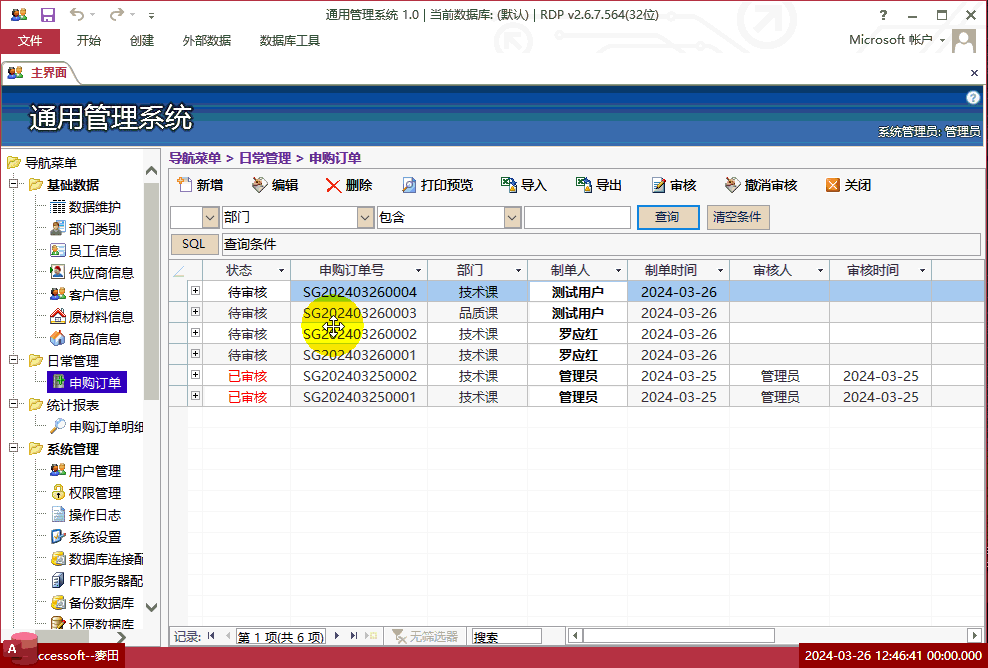SQL语句(五)常用语句
时 间:2012-04-17 09:14:07
作 者:欢乐小爪 ID:20149 城市:杭州
摘 要:SQL语句(五)常用语句
正 文:
用SQL语句添加删除修改字段
1.增加字段
alter table docdsp add dspcode char(200)
2.删除字段
ALTER TABLE table_NAME DROP COLUMN column_NAME
3.修改字段类型
ALTER TABLE table_name ALTER COLUMN column_name new_data_type
4.sp_rename 改名
更改当前数据库中用户创建对象(如表、列或用户定义数据类型)的名称。
语法
sp_rename [ @objname = ] 'object_name' ,
[ @newname = ] 'new_name'
[ , [ @objtype = ] 'object_type' ]
如:EXEC sp_rename 'newname','PartStock'
sp_rename 是一个功能丰富的存储过程,能够对 表、视图、列、存储过程、触发器、默认值、数据库、对象或 规则进行重命名,并且保证不丢失数据。
下例将TB_MoneyPay_PJApply表中的字段PayMoney修改为PaidCash:
- EXEC sp_rename 'TB_MoneyPay_PJApply.[PayMoney]', 'PaidCash', 'COLUMN'
sp_renamedb
更改数据库的名称。
下例将数据库 accounting 改名为 financial。
- EXEC sp_renamedb 'accounting', 'financial'
SQL Server 2005
添加字段 ALTER TABLE Supplier ADD LoginPassword varchar(20) 不需要加 COLUMN
修改表字段属性 ALTER TABLE Supplier ALTER COLUMN LoginPassword varchar(30)
5.sp_help 显示表的一些基本情况
sp_help 'object_name' 如:EXEC sp_help 'PartStock'
6.判断某一表PartStock中字段PartVelocity是否存在
if exists (select * from syscolumns where id=object_id('PartStock') and name='PartVelocity')
print 'PartVelocity exists'
else print 'PartVelocity not exists'
另法:
判断表的存在性:
select count(*) from sysobjects where type='U' and name='你的表名'
判断字段的存在性:
select count(*) from syscolumns
where id = (select id from sysobjects where type='U' and name='你的表名')
and name = '你要判断的字段名'
一个小例子
--假设要处理的表名为: tb
--判断要添加列的表中是否有主键
if exists(select 1 from sysobjects where parent_obj=object_id('tb') and xtype='PK')
begin
print '表中已经有主键,列只能做为普通列添加'
--添加int类型的列,默认值为0
alter table tb add 列名 int default 0
end
else
begin
print '表中无主键,添加主键列'
--添加int类型的列,默认值为0
alter table tb add 列名 int primary key default 0
end
7.随机读取若干条记录
Access语法:SELECT top 10 * From 表名 ORDER BY Rnd(id)
Sql server:select top n * from 表名 order by newid()
mysql select * From 表名 Order By rand() Limit n
8.说明:日程安排提前五分钟提醒
SQL: select * from 日程安排 where datediff(minute,f开始时间,getdate())>5
9.前10条记录
select top 10 * form table1 where 范围
10.包括所有在 TableA 中但不在 TableB和TableC 中的行并消除所有重复行而派生出一个结果表
(select a from tableA ) except (select a from tableB) except (select a from tableC)
11.说明:随机取出10条数据
select top 10 * from tablename order by newid()
12.列出数据库里所有的表名
select name from sysobjects where type=U
13.列出表里的所有的字段名
select name from syscolumns where id=object_id(TableName)
14.说明:列示type、vender、pcs字段,以type字段排列,case可以方便地实现多重选择,类似select 中的case。
select type,sum(case vender when A then pcs else 0 end),sum(case vender when C then pcs else 0 end),sum(case vender when B then pcs else 0 end) FROM tablename group by type
15.说明:初始化表table1
TRUNCATE TABLE table1
16.说明:几个高级查询运算词
A: UNION 运算符
UNION 运算符通过组合其他两个结果表(例如 TABLE1 和 TABLE2)并消去表中任何重复行而派生出一个结果表。当 ALL 随 UNION 一起使用时(即 UNION ALL),不消除重复行。两种情况下,派生表的每一行不是来自 TABLE1 就是来自 TABLE2。
B: EXCEPT 运算符
EXCEPT 运算符通过包括所有在 TABLE1 中但不在 TABLE2 中的行并消除所有重复行而派生出一个结果表。当 ALL 随 EXCEPT 一起使用时 (EXCEPT ALL),不消除重复行。
C: INTERSECT 运算符
INTERSECT 运算符通过只包括 TABLE1 和 TABLE2 中都有的行并消除所有重复行而派生出一个结果表。当 ALL 随 INTERSECT 一起使用时 (INTERSECT ALL),不消除重复行。
注:使用运算词的几个查询结果行必须是一致的。
17.说明:在线视图查询(表名1:a )
select * from (SELECT a,b,c FROM a) T where t.a > 1;
18.说明:between的用法,between限制查询数据范围时包括了边界值,not between不包括
select * from table1 where time between time1 and time2
select a,b,c, from table1 where a not between 数值1 and 数值2
19.说明:in 的使用方法
select * from table1 where a [not] in (‘值1’,’值2’,’值4’,’值6’)
20.说明:两张关联表,删除主表中已经在副表中没有的信息
delete from table1 where not exists ( select * from table2 where table1.field1=table2.field1 )
21. 说明:复制表(只复制结构,源表名:a 新表名:b) (Access可用)
法一:select * into b from a where 1<>1
法二:select top 0 * into b from a
22.说明:拷贝表(拷贝数据,源表名:a 目标表名:b) (Access可用)
insert into b(a, b, c) select d,e,f from b;
23.说明:跨数据库之间表的拷贝(具体数据使用绝对路径) (Access可用)
insert into b(a, b, c) select d,e,f from b in ‘具体数据库’ where 条件
例子:..from b in "&Server.MapPath(".")&"\data.mdb" &" where..
24.创建数据库
CREATE DATABASE database-name
25.说明:删除数据库
drop database dbname
26.说明:备份sql server
--- 创建 备份数据的 device
USE master
EXEC sp_addumpdevice disk, testBack, c:\mssql7backup\MyNwind_1.dat
--- 开始 备份
BACKUP DATABASE pubs TO testBack
27.说明:创建新表
create table tabname(col1 type1 [not null] [primary key],col2 type2 [not null],..)
根据已有的表创建新表:
A:create table tab_new like tab_old (使用旧表创建新表)
B:create table tab_new as select col1,col2… from tab_old definition only
28.说明:
删除新表:drop table tabname
29.说明:
增加一个列:Alter table tabname add column col type
注:列增加后将不能删除。DB2中列加上后数据类型也不能改变,唯一能改变的是增加varchar类型的长度。
30.说明:
添加主键:Alter table tabname add primary key(col)
说明:
删除主键:Alter table tabname drop primary key(col)
31.说明:
创建索引:create [unique] index idxname on tabname(col….)
删除索引:drop index idxname
注:索引是不可更改的,想更改必须删除重新建。
32.说明:
创建视图:create view viewname as select statement
删除视图:drop view viewname
33.说明:几个简单的基本的sql语句
选择:select * from table1 where 范围
插入:insert into table1(field1,field2) values(value1,value2)
删除:delete from table1 where 范围
更新:update table1 set field1=value1 where 范围
查找:select * from table1 where field1 like ’%value1%’ ---like的语法很精妙,查资料!
排序:select * from table1 order by field1,field2 [desc]
总数:select count * as totalcount from table1
求和:select sum(field1) as sumvalue from table1
平均:select avg(field1) as avgvalue from table1
最大:select max(field1) as maxvalue from table1
最小:select min(field1) as minvalue from table1
相关索引: 上一节 完
Access软件网官方交流QQ群 (群号:54525238) Access源码网店
常见问答:
技术分类:
源码示例
- 【源码QQ群号19834647...(12.17)
- 用Access连续窗体制作的树...(11.03)
- 【Access高效办公】上一年...(10.30)
- Access制作的RGB转CM...(09.22)
- Access制作的RGB调色板...(09.15)
- Access制作的快速车牌输入...(09.13)
- 【Access高效办公】统计当...(06.30)
- 【Access高效办公】用复选...(06.24)
- 根据变化的日期来自动编号的示例...(06.20)
- 【Access高效办公】按日期...(06.12)

学习心得
最新文章
- Access快速开发平台企业版--...(12.10)
- SqlServer默认当前时间用什...(11.28)
- 【Access日期时间区间段查询示...(11.19)
- Microsoft Access不...(11.07)
- 用Access连续窗体制作的树菜单...(11.03)
- 【Access高效办公】上一年度累...(10.30)
- Access做的一个《中华经典论语...(10.25)
- Access快速开发平台--加载事...(10.20)
- 【Access有效性规则示例】两种...(10.10)
- EXCEL表格扫描枪数据录入智能处...(10.09)




.gif)

